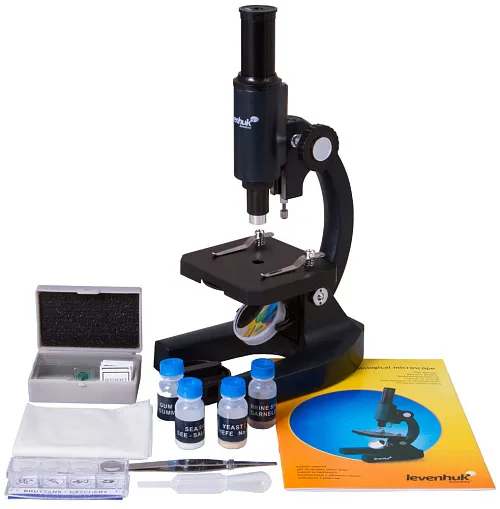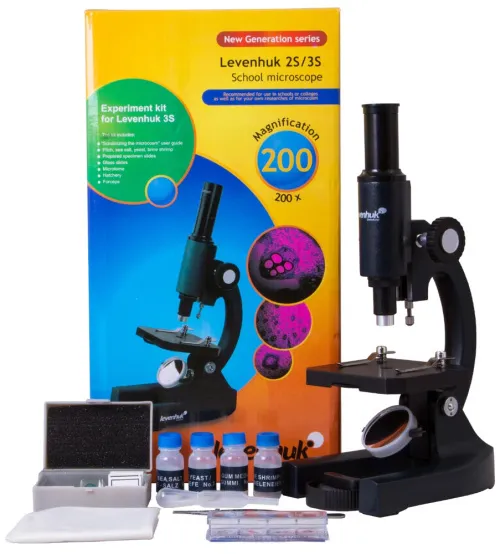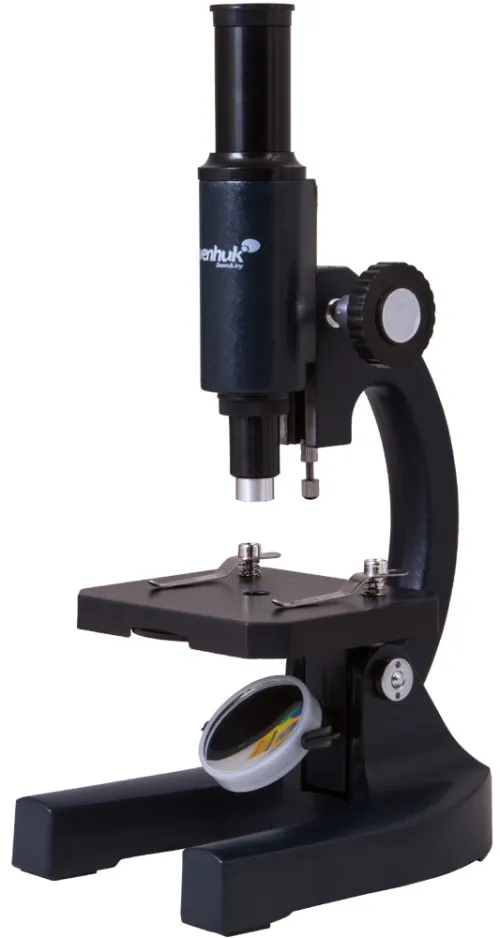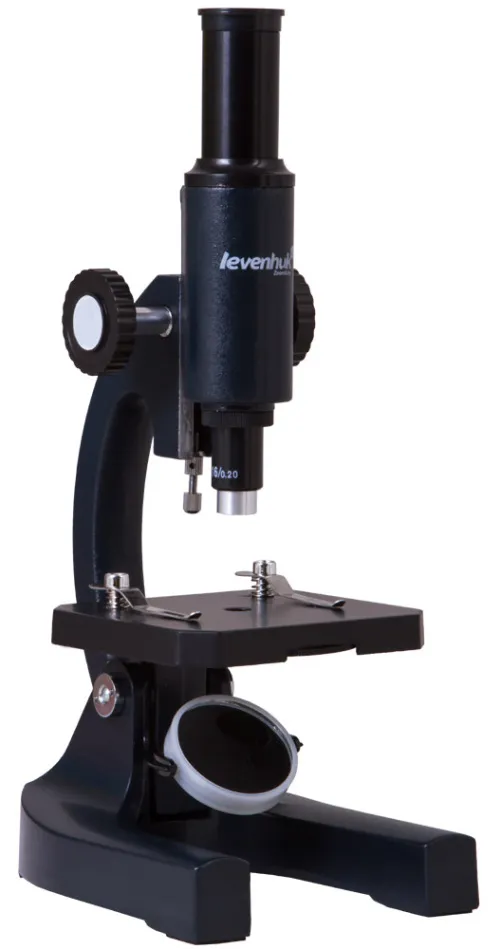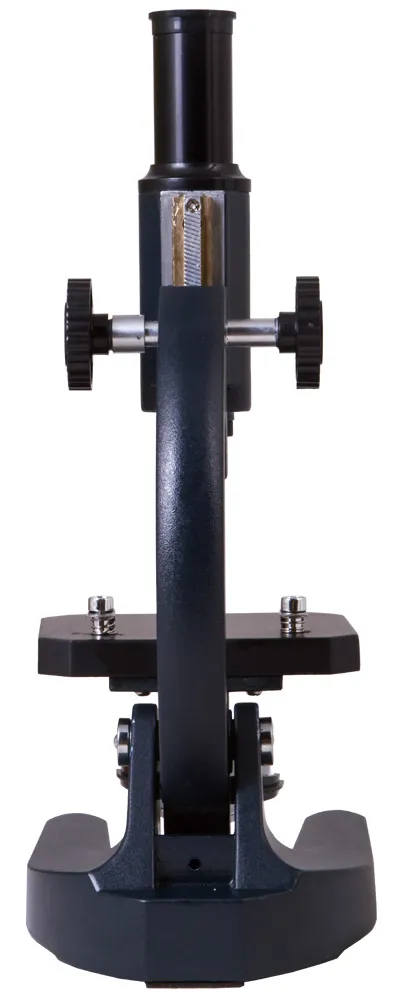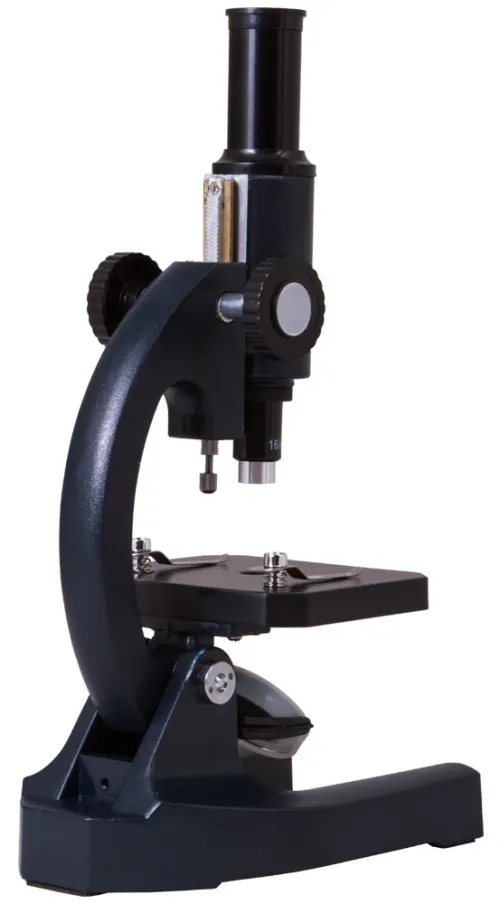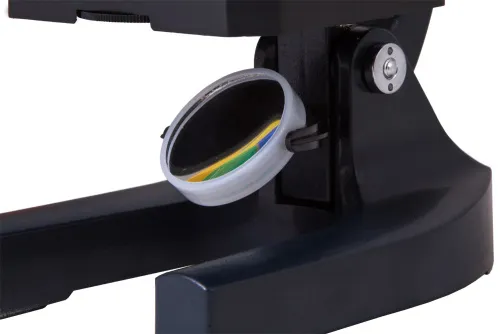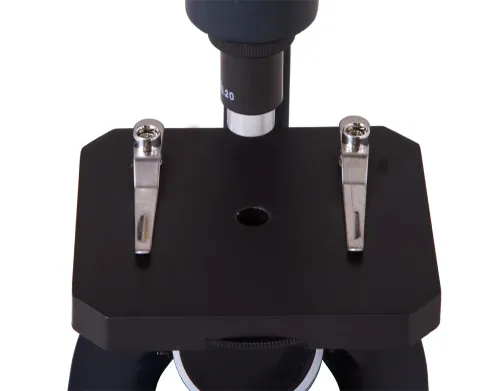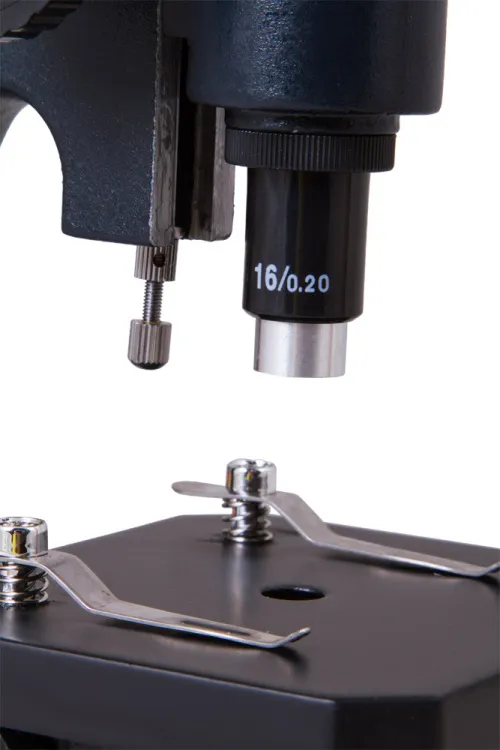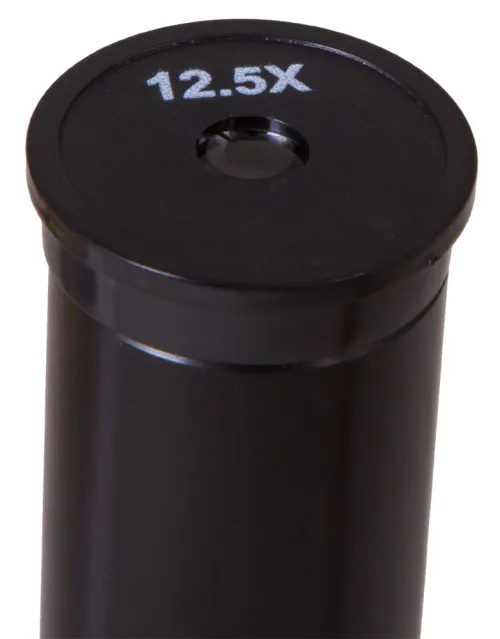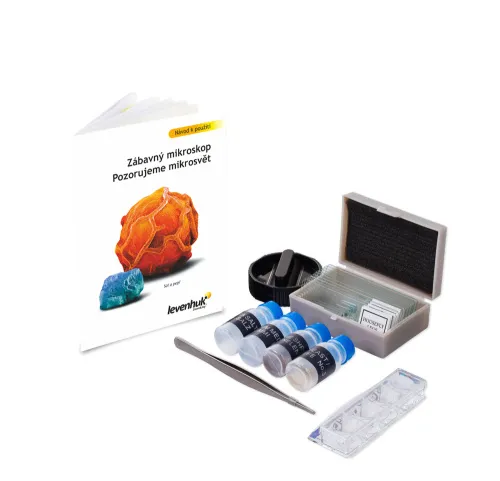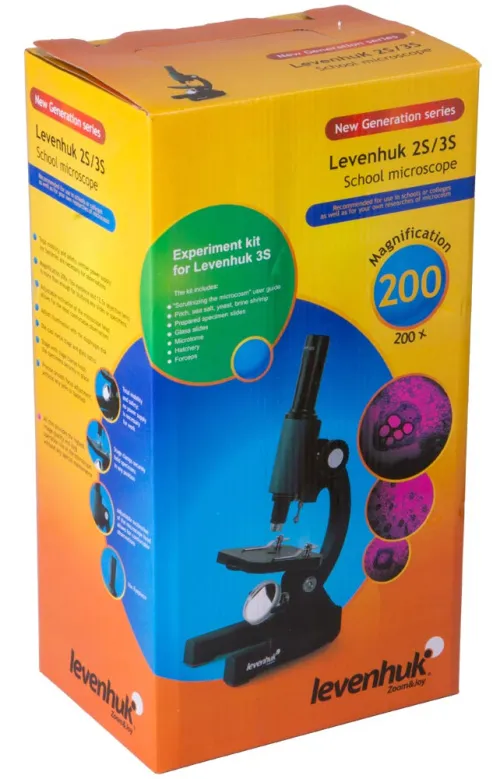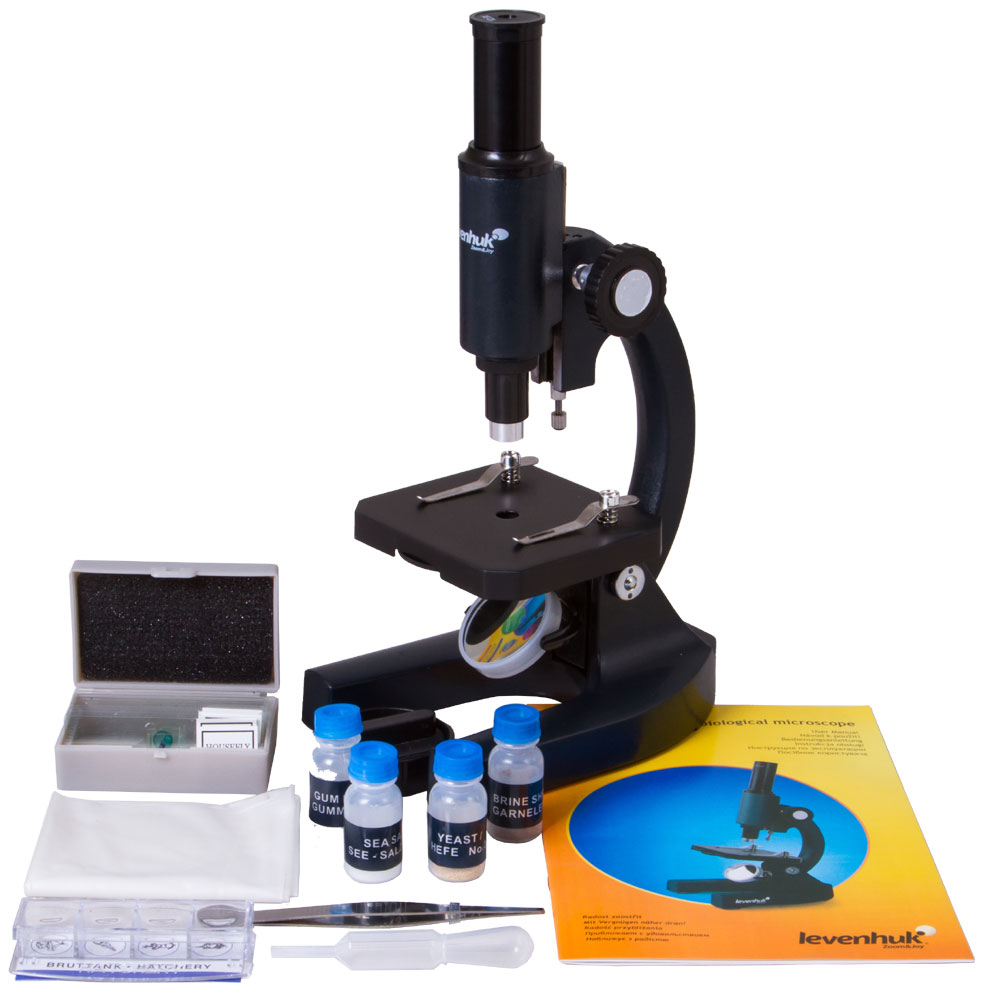Levenhuk 3S NG Monocular Microscope
Monocular. Magnification: 200x. Illumination: mirror. Also included: Levenhuk K50 Experiment Kit
| Product ID | 66823 |
| Brand | Levenhuk, Inc., USA |
| Warranty | lifetime |
| EAN | 5905555007939 |
| Package size (LxWxH) | 14x19x36 cm |
| Shipping Weight | 1.5 kg |
With the Levenhuk 3S NG you can begin your adventures in the world of science right after you take the microscope out of the box, with the included Experiment Kit. This model allows for bright field observations of transparent specimens. This microscope with its 200x magnification is a fantastic doorway into the marvels and mysteries of the microcosm for children, students, and amateurs alike.
The 40-mm (1.6-in) plano-concave mirror in the Levenhuk 3S NG models provides enough light for your observations, which means you can use this microscope without having to plug it in to a power source. This is the easiest and safest illumination method, which means that children can safely use this microscope. The diaphragm disk allows you to control the amount of light required for observations of the specimen.
This monocular microscope has a single 16x achromatic objective lens, which provides a clear view without any chromatic or spherical aberrations. In this model the head is located directly above the stage, but for comfortable observations you can incline both the head and the stage to the desired angle by the arm of the microscope.
The 100x90-mm (3.9x3.5-in) stage is perfect for observations of one or two specimens. To prepare the specimen, first place a sample on the blank slide, then slowly drop a cover slip over the sample. The resulting slide is then placed on the stage and secured in place with stage clips. Use the coarse focusing knob to focus your view by moving the body tube of the microscope up and down (at 20-mm (0.8-in) intervals).
The metal construction makes this microscope both sturdy and stable.
"Attractive Microscope. Scrutinizing the Microcosm" User Guide included in the kit will lead you through a number of biological experiments that you can perform at home. For this, you will use the specimens that are already supplied with the Levenhuk 3S NG Microscope; and in just a few minutes you will be looking into the unknown. You will learn how to prepare the samples, conduct experiments, analyze the results, and, of course, you will learn a lot about the world around you along the way.
The kit includes:
- Microscope with monocular head
- 16x achromatic objective lens
- H12.5x eyepiece
- Diaphragm disk
- Stage with the stage clips
- Plano-concave mirror for illumination
- Levenhuk K50 Experiment Kit
- User manual and lifetime warranty
Levenhuk K50 Experiment Kit includes:
- "Attractive Microscope. Scrutinizing the Microcosm" User Guide
- Hatchery for Artemia (brine shrimp, or sea-monkeys)
- Forceps
- Flask with brine shrimp
- Microtome—a tool that allows you to make very thin (fraction of a millimeter) slices of samples, which is necessary for studying samples under a microscope
- Flask with yeast
- Flask with sea salt
- Flask with pitch
- Blank glass slides (5 pieces)
- 5 samples: fly's limb, onion, cotton stem, slice of a tree trunk, pine
Some things you can see under a microscope:





Levenhuk 3S NG Microscope is compatible with Levenhuk digital cameras (purchased separately). Levenhuk cameras are installed in the eyepiece tube instead of an eyepiece.
| Product ID | 66823 |
| Brand | Levenhuk, Inc., USA |
| Warranty | lifetime |
| EAN | 5905555007939 |
| Package size (LxWxH) | 14x19x36 cm |
| Shipping Weight | 1.5 kg |
| Type | biological, light/optical |
| Microscope head type | monocular |
| Optics material | optical glass |
| Head | fixed (non-rotatable) |
| Head inclination angle | not angled |
| Magnification, x | 200 |
| Eyepiece tube diameter, mm | 23.2 |
| Eyepieces | 12.5x |
| Objectives | 16x (achromatic) |
| Stage, mm | 100x90 |
| Stage moving range, mm | fixed |
| Stage features | with clips |
| Diaphragm | diaphragm disc (6 apertures) |
| Focus | coarse (20mm) |
| Body | metal |
| Illumination | mirror |
| User level | beginners, elementary |
| Assembly and installation difficulty level | extremely simple |
| Application | elementary, school/educational |
| Illumination location | lower |
| Research method | bright field |
| Experiment kit included | ✓ |
| Pouch/case/bag in set | dust cover |
We have gathered answers to the most frequently asked questions to help you sort things out
Find out why studying eyes under a microscope is entertaining; how insects’ and arachnids’ eyes differ and what the best way is to observe such an interesting specimen
Read this review to learn how to observe human hair, what different hair looks like under a microscope and what magnification is required for observations
Learn what a numerical aperture is and how to choose a suitable objective lens for your microscope here
Learn what a spider looks like under microscope, when the best time is to take photos of it, how to study it properly at magnification and more interesting facts about observing insects and arachnids
This review for beginner explorers of the micro world introduces you to the optical, illuminating and mechanical parts of a microscope and their functions
All about Levenhuk microscopes
Short article about Paramecium caudatum - a microorganism that is interesting to observe through any microscope

